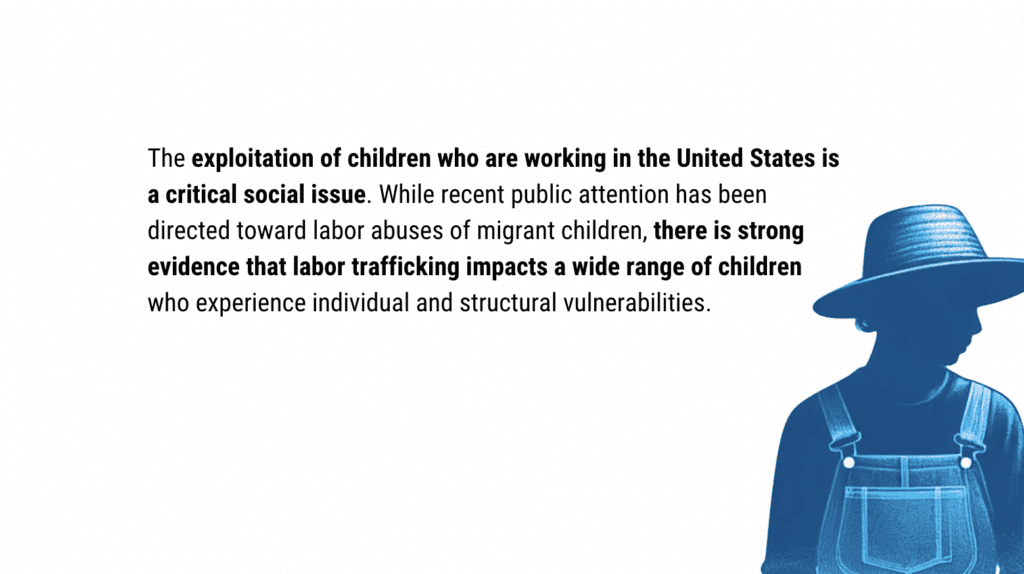A new study authored by Amy Farrell, Director of the School of Criminology and Criminal Justice at Northeastern, provides valuable insight into the victims and perpetrators of child labor trafficking. A largely misunderstood phenomenon, child labor trafficking affects a wide range of children, including children born in the US and abroad, in a variety of industries, from agriculture to domestic work.
Supported by National Institute of Justice, “Understanding Child Labor Trafficking in the United States,” study explored how the lack of understanding surrounding victims, and the complex circumstances that trap children in these situations, contributes to the inadequate response by first responders. In this study, first responders included police, immigration officials, schools, child welfare systems, juvenile justice systems, or labor inspectors.


The report showed that most first responders who work with children do not identify cases of child labor trafficking or misidentify cases of child labor trafficking. Farrell and the other authors of the report incl Meredith Dank, New York University, Katherine Kaufka Walts, Loyola Law SchoolCallie Hansson, Northeastern University, Andrea Hughes, New York Universityand Chlece Neal, Loyola School of Lawwe hope this new research will fill in the gaps, helping first responders to more accurately and effectively identify cases of child labor trafficking.
This study is the first comprehensive examination of child labor trafficking in the US and provides detailed information on the nature of child labor trafficking. Key findings included:
Work is a fundamentally important part of a young person's development, but when that work is abusive, coercive or harmful, there are long-term consequences for young people, their families and their communities,” Farrell said. “We are optimistic that the solutions we propose will fundamentally improve the conditions under which young people work, learn and develop.”
As part of the study, Farrell and team provided several recommendations:
- Align state laws with federal anti-trafficking laws to ensure that laws and policies that protect child sex trafficking survivors also include child labor trafficking survivors.
- Provide additional training to all stakeholders dealing with children on child labor trafficking, including education/schools, law enforcement, immigration officials, child welfare systems, juvenile justice systems and labor inspectors.
- Functioning of screening and services for victims of child trafficking for labor on par with child sex trafficking.
- Consider recognizing all cases of child labor exploitation as a form of child labor trafficking, especially given children's limited ability to distinguish between forced or compulsory labor and voluntary labor.
- Explore opportunities to expand vocational programs to provide valuable skills while offering safe, legal employment opportunities to children.
- Create safe, rapid, subsidized alternative housing options for minors, regardless of immigration status.
- Explore opportunities for temporary legal protection for noncitizen children to minimize their unique vulnerabilities to aggressive labor exploitation and make them eligible for participation in existing youth and young adult career and career readiness programs.
- Expand post-release services and supports to non-citizen children released from federal custody in US communities living with sponsors to ensure children and family receive the support they need.
- Work with immigration attorneys and law school clinics to provide comprehensive legal assistance to alien minors in schools, including work authorization, visa applications, and removal.
- Strengthen penalties for civil violations of child labor and child labor exploitation laws to ensure consistency in protections between state and federal laws.
Trafficking of minors for labor is multi-layered and more difficult to detect than cases of trafficking in adults due to the unique vulnerabilities of the child. Children rely on adults for their basic needs, changing the definition of “coercion,” which categorizes labor trafficking. Solutions to this complex and complex issue rely on the collaborative and interdisciplinary work of law enforcement, researchers, and educational institutions.
To learn more see the full report.



